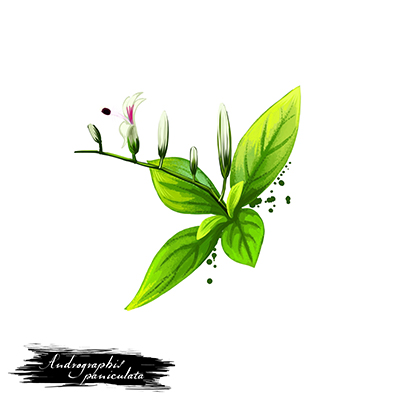The immune system is a natural defense that fights against invading pathogens and thus protects the host from severe infection.
Though immunity is a natural ability of an individual to fight against infections, it can be greatly influenced by certain extrinsic factors such as food and lifestyle.
Various plants have been used since eternity to maintain healthy immune function and growing data on drug research has uncovered the immune-strengthening ability of certain plant-derived bioactives.
Andrographis paniculata is one such plant, whose bioactives modulates the immune components and acts synergistically with the immune system to improve its overall defending ability.
Figure 1 is an herbaceous plant belonging to the Acanthaceae family and can be found throughout tropical and subtropical regions of Asia including India.
The plant has been used in traditional therapy to provide relief from the severity of common cold and flu. The bioactives were shown to positively affect the liver and serum enzymes and possess immune-supporting functions.
Research studies speculate that the immune-supporting and modulatory potential of the bioactives is mediated through their inhibiting ability of Lipopolysaccharide (LPS) stimulated nitric oxide production and NF-κB activation in macrophages1.
There is improved activitity of cytotoxic T cells, natural killer (NK) cells, and antibody-dependent cell-mediated cytotoxicity2.
Lastly, the ability to inhibit against certain viral strains is also predominant3.
A clinical study on the subjects with flu has revealed that the administration of A. paniculata extract reduces the severity of symptoms and duration of cold and flu4.
The research studies conclude that the A. paniculata acts as an immunomodulator by inhibiting the propagation of pathogens (viruses and bacteria) and by eliciting the right amount of immune response. The product can find its application in formulations aiming to support a healthy immune system.

References
- Bao Z, Guan S, Cheng C, et al., A novel anti-inflammatory role for andrographolide in asthma via inhibition of the nuclear factor-kappaB pathway. Am J Respir Crit Care Med. 2009;179(8):657-665.
- Gupta S, Mishra KP, Ganju L. Broad-spectrum antiviral properties of andrographolide. Arch Virol. 2017;162(3):611-623.
- Chen JX, Xue HJ, Ye WC, et al., Activity of andrographolide and its derivatives against influenza virus in vivo and in vitro. Biol Pharm Bull. 2009;32(8):1385-1391.
- Jaber R. Respiratory and allergic diseases: from upper respiratory tract infections to asthma. Prim Care. 2002;29(2):231-261.
